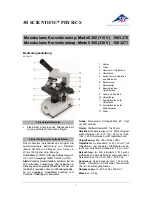
CHAPTER 2 - SAMPLE PREPARATION
Carl Zeiss
Tips, Troubleshooting and Additional Information
Lightsheet Z.1
38
000000-1790-528
02/2013
Sample image is unclear, blurred or has insufficient contrast.
−
This can be a simple optical problem: objectives or filters are dirty. Clean them accordingly. You can
also check that all the components are well in place and aligned.
−
Your light sheet might not be properly aligned. For Lightsheet Z.1, please realign the light sheet
using the Light sheet auto-adjust function of the ZEN software.
−
You could be imaging through an additional layer of material: glass, plastic... that belong to the
mounting support and not the sample itself. Please, check the sample position or move it around to
see if another angle solve the problem as a piece of glue, additional agarose or part of the
mounting material is having a blurring effect.
−
In the case of sample embedding it may occur that the gelling media is of low quality or badly
polymerized. This leads to an uneven polymerization of the media that modify the optical path. Try
again.
−
The light sheet comes from the side and any obstacle modifies its quality. Check the illumination
axis for any obstacle (capillary, objects…).
−
Check if the medium level in the sample chamber has dropped below the imaging level. The
specimen has to be fully immersed for good image quality.
Sample image is partially obscured or unevenly illuminated.
−
This can be a simple optical problem: objectives or filters are dirty. Clean them accordingly. You can
also check that all the components are well in place and aligned.
−
Your light sheet might not be properly aligned. For Lightsheet Z.1, please realign the light sheet
using the Light sheet auto-adjust function of the ZEN software.
−
The light sheet comes from the side and any obstacle modifies its quality. Check the illumination
axis for any obstacle (capillary, objects…).
Sample signal is weak.
−
Human eyes have trouble quickly adjusting to the dark and it will be hard to discern a very dim
fluorescent specimen immediately after darkening the room. You may want to check your sample
using another microscope or a stereomicroscope equipped with a fluorescent lamp.
−
It could be an optical problem, e.g. extra filter in the optical path, misaligned illumination or dying
laser. You can also increase excitation energy (laser). However, the risk of bleaching and signal
saturation will increase.
−
In the case of immunofluorescence, you should increase antibody concentration or incubation time
but this might in turn increase nonspecific background signal.
−
In the case of GFP signal, the expression level might be too low or you have photobleached or
damaged the GFP signal during sample preparation (fixation, ethanol treatment, excessive
illumination during dissection...).
Содержание Lightsheet Z.1
Страница 1: ...Lightsheet Z 1 Operating Manual February 2013 ZEN 2012 black edition ...
Страница 4: ......
Страница 170: ......
Страница 427: ...Lightsheet Z 1 Overview ...
















































